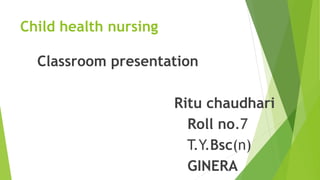
pneumonia.pptx
- 1. Child health nursing Classroom presentation Ritu chaudhari Roll no.7 T.Y.Bsc(n) GINERA
- 4. Introduction: Pneumonia is lung infection that affect the air sac (alveoli) at the end of the airways. The infection interferes with the delivery of oxygen from the air sacs into the blood and the removal of carbon dioxide from the blood.
- 5. Definition: Pneumonia is defined as acute inflammation and consolidation of lung parenchyma.
- 6. Incidence Pneumonia in children is a major concern in developing countries, because one third of all hospitals outpatient compromise of acute respiratory infection of which nearly 30% have pneumonia. It is the second leading cause of death in children under 5 year of age.
- 7. Classification : Classification on anatomic basis: 1. Lobular pneumonia:one or more lobes of lungs are involved. 2. Interstitial pneumonia: interstitial tissues of lungs are affected. 3. Bronchopneumonia: patchy consolidation of lungs is known as bronchopneumonia.
- 8. Classification on etiologic basis: 1. Bacterial pneumonia: It may be caused by bacteria like pneumococcus, streptococcus, staphylococcus,H.influenzae ,and Haemophilus pertussis. 2. Viral pneumonia: It may be caused by viruses like influenza, measles, adenovirus and respiratory syncytial virus.
- 9. 3. Fungal pneumonia:It may be caused by histoplasmosis and coccidioidomycosis. 4. Protozoal pneumonia:It may be caused by pneumocystis carinii,Toxoplasma gondii, and Entamoeba histolytica.
- 10. Miscellaneous types: 1. Aspirations pneumonia: it is caused by aspirations of food,nasal drops, amniotic fluid by newborn, water (drowning)and chemical like kerosene oil,etc. 2. Loffler’s pneumonia:It is a disease in which eosinophils accumulate in lungs in response to parasitics infection. It may be caused by parasites like Ascaris lumbricoides ,strongyloides stercoralis and Ancyclostoma duodenale.
- 11. 3.Hypersensitivity pneumonia: It is an inflammation of alveoli within the lungs caused by hypersensitivity to inhaled dust. 4.Hypostatic pneumonia: It is results from collection of fluid in dorsal region of lungs and occurs especially in those confined to bed for long time (bedridden person).
- 12. Risk factors: Immunosuppressants state like HIV , AIDS Exposure to smoke and chemical Aspiration of any substance
- 13. Pathophysiology infection to the lungs (e.g bacteria, virus) ⬇️ inflammatory response initiated ⬇️ Alveolar edema+exudate formation ⬇️ Alveoli and respiratory bronchiole fill with serous exudate, blood cells, fibrin, bacteria ⬇️ Consolidation of lung tissue
- 14. By chart
- 16. Clinical Features: Clinical features of pneumonia include: High fever with chills Cough with thick sputum Increased respiratory rate Grunting respiration Nasal flaring Running nose Irritability Malaise
- 19. Sore throat Anorexia Late symptoms include: Convulsions Drowsiness Inability to drink from mouth Wheezing
- 21. Hoarseness of voice Cyanosis Pleural pain which may be increased by deep breathing
- 22. Diagnostic evaluation History of the child reveals presence of cough with increased respiration. Chest X-ray: X-ray suggesting bronchopneumonia include diffuse patchy consolidation of lung. Blood test reveals increased blood count with polymorphonuclear leukocytosis seen in bacterial pneumonia.
- 24. Diagnosis is confirmed by isolating the oraganism in blood or from pleural fluid. Isolation of organism from nasopharynx or throat by culture or polymerase chain reaction (PCR)in viral pneumonia.
- 25. Management Antibiotics used in treatment of bacterial pneumonia Includes penicillin, Amoxicillin, and clavulanic acid , and macrolides like erythromycin, Azithromycin, and clarithromycin.
- 26. For fungal pneumonia provide antifungal drugs like Amphotericin B,fluconazole, sulphonamide. Provide supportive Care the child: Oxygen administration to maintain the oxygen saturation level. Hydration therapy Antipyretics (paracetamol 10-15mg/kg every 4-6 hour )
- 27. Nursing management Ineffective airways clearance related to excessive mucus production secondary to retained secretions and inflammation. Ineffective breathing pattern related to inflammatory process, hypoxia,or alteration in patient oxygen and carbon dioxide ratio as evidenced by tachypnea , dyspnea or change in rate and depth of respiration.
- 28. Hyperthermia or imbalance body temperature related to inflammatory process of pneumonia as evidenced by measuring vital signs. Risk for imbalance nutrition less than body requirements related to inability to swallow Or increased metabolic needs secondary to infectious process or fever.
- 29. Risk for infection related to inadequate primary defence or chronic disease or malnutrition.
- 30. Nursing interventions Monitor the child’s respiratory rate and pattern. Administer oxygen to maintain the oxygen saturation in blood. Place the child in semi – fowler’s position to help in breathing. Position of the child should be changed frequently to prevent pooling of secretions in lungs.
- 31. Administer cough suppressant and bronchodilator as per prescription. Provide steam inhalation and chest physiotherapy to help in drainage of secretions. Give increased amount of fluids as this will help in liquefying the thick tenacious secretions. Administer prescribed antibiotics. Tepid sponging is done to reduce fever. Provide diversion therapy to the child to avoid boredom.
- 32. Complications Complications of pneumonia including: Pleural effusion Emphysema Bronchiectasis Pneumatocele
- 33. Prevention Two vaccine are available to prevent pneumonia: 1. Pneumococcal conjugate vaccine (PCV13) 2. Pneumococcal polysaccharides vaccine (ppsv23) PCV13 recommend for all children less than 2 years of age.